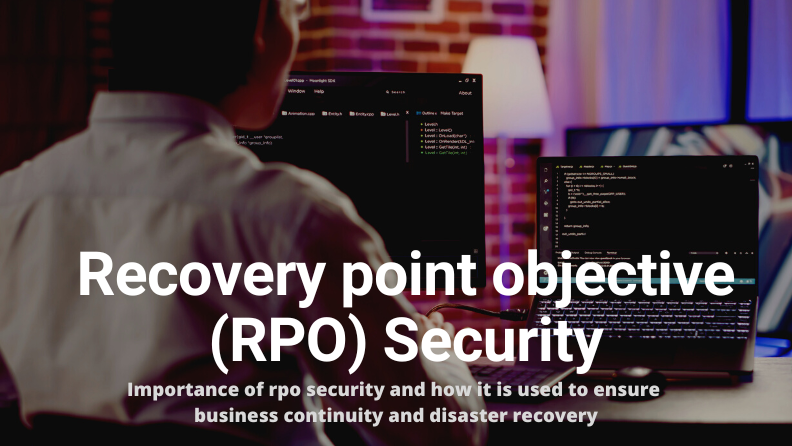Recovery point objective (RPO) is a metric that measures the maximum amount of data loss a business can tolerate. It is a ‘period of time’ metric that measures the maximum amount of data loss a business can tolerate in the event of a disaster or system failure.
The importance of RPO lies in its ability to provide a clear understanding of the impact of data loss on the business and help organizations plan and implement effective disaster recovery strategies to minimize data loss and disruption to business operations. By setting a well-defined RPO, organizations can ensure the availability of critical data and applications, reducing the risk of lost revenue, reputation damage, and other adverse effects of extended downtime.
This blog will look at the RPO metric and why it is so important.
Ready to protect your app?
Start 30-days FREE TRIAL. No credit card required. Deliver Secure Mobile Apps Faster in minutes with the leader in application security.

Recovery Point Objective (RPO)
Recovery Point Objective (RPO) is used in disaster recovery and business continuity planning. It refers to the time when an organization’s data must be recovered after a disaster or disruption.
It is a critical aspect of disaster recovery planning as it determines the maximum amount of data loss that can be tolerated before it becomes a significant issue for the organization. The RPO is typically measured in terms of time, such as the number of minutes, hours, or days that can elapse between the last successful data backup and the point of failure.
Read on to learn more about this essential data protection strategy and how it can help you in a disaster.
Examples of RPOs
RPOs (recovery point objectives) should be different for each organization, and they should also be based on how critical the organization’s operation is. This is because the RPO requirement is directly connected to the organization’s risk tolerance—basically, how much they’re willing to lose—and the impact of data loss on its operations.
Some examples of RPOs include the following:
- For a retail company, an RPO of 2 hours might be acceptable, as the company could still function relatively well even if it loses a couple of hours of sales data.
- For a financial institution, an RPO of 15 minutes might be more appropriate, as any loss of financial transaction data could have significant consequences.
- An RPO of 0 (zero) for a hospital could be necessary as any patient data loss can have dire consequences.
- For a news agency, an RPO of a few minutes could be acceptable as they need to be able to publish breaking news stories as soon as they happen.
- For a manufacturing company, an RPO of 24 hours could be tolerable as the company can afford to lose a day’s production data. Still, they need to have the ability to restore their systems to normal operation as soon as possible.
It’s important to note that the RPO is a trade-off between the cost of maintaining the disaster recovery infrastructure and the potential cost of data loss.
Key Recovery Objectives
Key recovery objectives are specific goals that an organization must meet to recover successfully from a disaster or disruption.
Some key recovery objectives include the following:
- Recovery Point Objective (RPO): The maximum amount of time an organization can afford without access to its critical systems and data following a disaster or disruption.
- Recovery Time Objective (RTO): The point in time at which an organization’s data must be recovered after a disaster or disruption.
- Data Integrity: Ensuring that the data recovered is accurate, complete, and consistent.
- Compliance: Ensure the recovery process adheres to relevant industry or regulatory standards.
- Business Continuity: Ensuring the organization can maintain its critical business processes and services during and after a disruption.
- Cost-effectiveness: Ensuring that the recovery plan is cost-effective and that the benefits of the recovery plan outweigh the costs.
- Testing and Validation: Regularly testing the recovery plan to ensure it works as intended and validate that the objectives are met.
- Communication: Having a communication plan to keep stakeholders informed during a disaster and after the recovery process.
- Staffing and Training: Having adequate staff trained and ready to respond to a disaster.
These objectives are tailored to your organization’s specific needs and are determined during the risk assessment and business impact analysis.
Factors Involved To Calculate RPO
Recovery Point Objective depends on several factors, as listed below:
- Business criticality: The RPO will be higher for systems that are critical to the functioning of the business and lower for less critical systems.
- Data change rate: The RPO is generally higher for systems with a high rate of data change and lower for systems with a low rate of data change.
- Backup frequency: The RPO will be lower if backups are performed more frequently.
- Recovery time: A shorter recovery time necessitates a lower RPO.
- Backup storage: The RPO is kept lower if the backup storage is more reliable and has a faster recovery time.
- Compliance and regulatory requirements: Some industries have specific data recovery and retention requirements that may affect the RPO.
- IT budget and resources: The RPO may be affected by the organization’s IT budget and the resources available to implement and maintain. For a robust disaster recovery plan, you need to consider the above mentioned factors for calculating the RPO.
Matching RTO/RPOs to Apps
The RTO and RPO for each application should be determined based on its criticality to the business and the data change rate.
- High-criticality applications, such as customer databases, should have a low RTO and RPO. This means that they should be recovered quickly and that minimal data loss is acceptable.
- Medium-criticality applications, such as email or collaboration tools, should have a moderate RTO and RPO.
- Low-criticality applications, such as test or development environments, can have a higher RTO and RPO as the recovery of these applications is not as critical to the business.
You must evaluate each application individually to determine its specific RTO and RPO requirements. This will help ensure that your disaster recovery plan is tailored to your organization’s needs and that resources are appropriately allocated.
Execution: Balancing Criticality and Cost
Executing an RPO that balances criticality and cost can be a challenging task. The criticality of an application or system determines the maximum amount of data loss that can be accepted. At the same time, cost considerations include the expense of backup and recovery processes and potential data loss.
To balance both, you can consider the following points:
- Consider implementing a tiered approach to backup and recovery. Critical systems are backed up more frequently and have a lower RPO, while less critical systems are backed up less frequently and have a higher RPO.
- Regularly review the RPO and RTO for each application and system. Business requirements and technology change over time, so it is important to check the RPO and RTO periodically to ensure they are still appropriate.
- Implementing a disaster recovery plan with an active-active architecture can also help achieve lower RPO. With such architecture, data is replicated in real-time, reducing the amount of data lost during a disaster.
- Cloud backup solutions can be cost-effective, especially for organizations with a high data change rate. The cost of cloud storage is usually based on the amount of data stored, so you only pay for the storage you need.
Ultimately, it is important to balance criticality and cost when determining the RPO for an application or system. Therefore, the goal should be to achieve a low RPO for critical systems while minimizing costs.
Long-Term RPO and RTO Optimization
In the context of a cyberattack, RPO and RTO optimization are key factors to consider when trying to minimize the damage caused by the attack and return to normal operations as quickly as possible. In addition, long-term RPO and RTO optimization involves regularly reviewing and updating the disaster recovery plan to ensure that it can effectively protect the organization in the event of a future attack.
Here are a few considerations you can make for long-term RPO and RTO optimization:
- Continuously monitor and analyze data change rates: As data change rates increase, the RPO needs to be adjusted accordingly to ensure that critical systems are protected.
- Evaluate new technologies: New technologies such as cloud-based disaster recovery solutions, active-active architectures, and artificial intelligence can help optimize RPO and RTO.
- Test the disaster recovery plan regularly: Regular testing of the disaster recovery plan helps identify any weaknesses and ensures that it can be executed successfully in the event of a disaster.
- Train employees: Periodic training of employees on the disaster recovery plan ensures that they are familiar with the procedures and can execute them effectively if and when disaster strikes.
Failover and RPO
Failover refers to switching to a backup system or secondary site in a disaster. There are several types of failover methods that organizations can use to ensure that their systems and applications are protected in the event of a disaster:
- Active-Passive: In this type of failover, a secondary system or site is maintained in a passive state, ready to take over processing if the primary system or site fails.
- Active-Active: In this method, multiple systems or sites are maintained in an active state, and processing is distributed among them. In the event of a failure of one system or site, the others take over the processing automatically.
- Manual: It involves a manual intervention to switch to a secondary system or site. This method is less reliable than other failover types as it depends on human intervention.
- Geographically redundant: This requires maintaining a secondary site in a different geographic location.
- Cloud-based: It involves replicating data to a cloud-based secondary system or site so that the data can be quickly restored from the cloud during a disaster.
- Hybrid: This is a combination of different failover methodologies.
The appropriate failover method will depend on your organization’s needs and requirements, such as RPO, RTO, budget, and resources. Therefore, it is important to evaluate and test the failover methods and choose the one that best fits your requirements.
How is Data Recovered After a Disaster?
To recover data after a disaster with a specific recovery point objective, you need to have a disaster recovery plan that includes regular data backups.
The specific steps for data recovery will depend on the type of disaster and the backup and disaster recovery solutions implemented. However, a general overview of the process is as follows:
Assess the disaster:
The first step is to assess the extent of the disaster and determine if it is possible to recover any data. This will depend on the type of disaster (e.g., fire, flood, cyber attack, etc.) and the location of the backups.
Identify the last backup:
The next step is identifying the previous backup created before the disaster occurred. This is typically the most recent backup that meets your organization’s RPO.
Restore from backup:
Once the last backup has been identified, the data can be restored. This may involve restoring the entire backup or just specific files or databases.
Test the restore:
After the data is restored, it is important to test that it is complete and accurate. This will ensure that your organization has the necessary data to resume operations.
Implement the DR plan:
Once the data is restored, you can implement the disaster recovery plan to resume operations. This may involve moving to a secondary site or using cloud-based services.
Review and update the plan:
After the disaster recovery process is completed, it’s important to review and update your organization’s disaster recovery plan to ensure that it can effectively handle future disasters.
It’s worth noting that in some cases, the recovery process can take time and may require a significant effort. The recovery time will depend on the complexity of the environment, data size, and the backup method.
Final Thoughts
Recovery Point Objective is an important metric in disaster recovery planning as it measures the maximum amount of data that can be lost before it affects your business. Achieving a low RPO requires a combination of different strategies and technologies, such as cloud backup, active-active architectures, and regular disaster recovery plan testing.
Organizations should prioritize their applications and systems based on their criticality to the business and match RPO and RTO accordingly. The appropriate RPO will depend on various factors, such as data change rate, backup frequency, recovery time, and budget. Implementing a failover plan is also crucial in maintaining a low RPO as it ensures that critical systems and applications can be quickly restored during a disaster and minimize data loss.
Ready to protect your app?
Start 30-days FREE TRIAL. No credit card required. Deliver Secure Mobile Apps Faster in minutes with the leader in application security.







